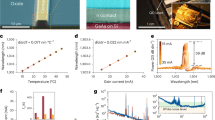Abstract
The development of ultra-intense lasers1 has facilitated new studies in laboratory astrophysics2 and high-density nuclear science3, including laser fusion4,5,6,7. Such research relies on the efficient generation of enormous numbers of high-energy charged particles. For example, laser–matter interactions at petawatt (1015 W) power levels can create pulses of MeV electrons8,9,10 with current densities as large as 1012 A cm-2. However, the divergence of these particle beams5 usually reduces the current density to a few times 106 A cm-2 at distances of the order of centimetres from the source. The invention of devices that can direct such intense, pulsed energetic beams will revolutionize their applications. Here we report high-conductivity devices consisting of transient plasmas that increase the energy density of MeV electrons generated in laser–matter interactions by more than one order of magnitude. A plasma fibre created on a hollow-cone target guides and collimates electrons in a manner akin to the control of light by an optical fibre and collimator. Such plasma devices hold promise for applications using high energy-density particles and should trigger growth in charged particle optics.
This is a preview of subscription content, access via your institution
Access options
Subscribe to this journal
Receive 51 print issues and online access
$199.00 per year
only $3.90 per issue
Buy this article
- Purchase on Springer Link
- Instant access to full article PDF
Prices may be subject to local taxes which are calculated during checkout




Similar content being viewed by others
References
Perry, M. D. & Mourrou, G. Terawatt to petawatt subpicosecond lasers. Science 264, 917–924 (1994)
Remington, B. A., Arnet, D., Drake, R. P. & Takabe, H. Modeling astrophysical phenomena in the laboratory with intense lasers. Science 284, 1488–1493 (1999)
Ledingham, K. W. D., McKenna, P. & Singhal, R. P. Applications for nuclear phenomena generated by ultra-intense lasers. Science 300, 1107–1111 (2003)
Tabak, M. et al. Ignition and high gain with ultra powerful lasers. Phys. Plasmas 1, 1626–1634 (1994)
Kodama, R. et al. Fast heating of ultrahigh-density plasma as a step towards laser fusion ignition. Nature 412, 798–802 (2001)
Key, M. H. Fast track to fusion energy. Nature 412, 775–776 (2001)
Kodama, R. et al. Fast heating scalable to laser fusion ignition. Nature 418, 933–934 (2002)
Wharton, K. B. et al. Experimental measurements of hot electrons generated by ultraintense (> 1019W/cm2) laser plasma interactions on solid-density targets. Phys. Rev. Lett. 81, 822–825 (1998)
Key, M. H. et al. Hot electron production and heating by hot electrons in fast ignitor research. Phys. Plasmas 5, 1966–1972 (1998)
Kodama, R. et al. Fast ignition research at the Institute of Laser Engineering Osaka University. Phys. Plasmas 8, 2268–2274 (2001)
Sentoku, Y. et al. Laser light and hot electron micro focusing using a conical target. Phys. Plasmas 11, 3083–3087 (2004)
Kitagawa, Y. et al. Prepulse-free petawatt laser for a fast ignitor. IEEE J. Quant. Electron. 40, 281–293 (2004)
Kodama, R. et al. in Inertial Fusion Science and Application 2003 (eds Hammel, B. A., Meyerhofer, D. D., Meyer-ter-Vehn, J. & Azechi, H.) 333–338 (American Nuclear Society, Illinois, 2004)
Kodama, R. et al. Development of a two-dimensional space-resolved high speed sampling camera. Rev. Sci. Instrum. 70, 625–628 (1999)
Zimmerman, G. B. & Kruer, W. L. Numerical simulation of laser-initiated fusion. Comment Plasma Phys. Controlled Fusion 2, 51–61 (1975)
Fill, E. et al. in X-ray Lasers 1998 (eds Kato, Y., Takuma, H. & Daido, H.) 301–308 (Inst. Phys. Conf. Ser. No. 159, IOP Publishing, Bristol, 1999)
Tanaka, K. A. et al. Calibration of imaging plate for high energy electron spectrometer. Rev. Sci. Instrum. (in the press)
Acknowledgements
We thank the target fabrication, laser operation and acquisition groups at ILE Osaka University. G.R.K. thanks JSPS for support.
Author information
Authors and Affiliations
Corresponding author
Ethics declarations
Competing interests
The authors declare that they have no competing financial interests.
Rights and permissions
About this article
Cite this article
Kodama, R., Sentoku, Y., Chen, Z. et al. Plasma devices to guide and collimate a high density of MeV electrons. Nature 432, 1005–1008 (2004). https://doi.org/10.1038/nature03133
Received:
Accepted:
Issue Date:
DOI: https://doi.org/10.1038/nature03133
This article is cited by
-
Time-resolved measurements of fast electron recirculation for relativistically intense femtosecond scale laser-plasma interactions
Scientific Reports (2018)
-
Dense GeV electron–positron pairs generated by lasers in near-critical-density plasmas
Nature Communications (2016)
-
Guided post-acceleration of laser-driven ions by a miniature modular structure
Nature Communications (2016)
-
Strong sub-terahertz surface waves generated on a metal wire by high-intensity laser pulses
Scientific Reports (2015)
-
Multi-MeV quasi-mono-energetic electron beam generation from interaction of ultraintense laser pulse with solid target at grazing incidence
Applied Physics B (2015)
Comments
By submitting a comment you agree to abide by our Terms and Community Guidelines. If you find something abusive or that does not comply with our terms or guidelines please flag it as inappropriate.



